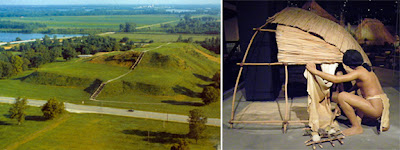Left Cahokia Mound, oldest in North America,
dated to 700 A.D.-1400 A.D.; Right: Typical Cahokia Mound Builder house, 700 A.D.-1400
A.D.
While the Mound Builders piled
up dirt and built homes of sticks and grass, Nephi tells us he taught his people
to “build buildings, and to work in all manner of wood, and of iron, and of
copper, and of brass, and of steel, and of gold, and of silver, and of precious
ores, which were in great abundance. And I, Nephi, did build a temple; and I
did construct it after the manner of the temple of Solomon save it were not
built of so many precious things; for they were not to be found upon the land,
wherefore, it could not be built like unto Solomon's temple. But the manner of
the construction was like unto the temple of Solomon; and the workmanship
thereof was exceedingly fine” (2 Nephi 5:15-16). Solomon's Temple, of course, was built out of stone.
Left: Solomon’s Temple about 950 B.C.; Right:
Typical Jerusalem House, about 750 B.C.
The building ability of
Israel hundreds of years before Lehi left Jersualem was astounding, which we
might conclude Nephi, who was quite familiar with it, carried over to some
degree, having received tutelage in building directly from the Lord, to show
some type of similar construction in the Land of Promise. However the ability
of the Mound Builders never developed higher than stick and grass houses or
piling dirt up to make mounds for burial purposes, but seems to serve little or no other purpose. Thus,
the difference between the Mound Builders in ancient America and those of the
Nephites, as shown cannot even be compared.
Left: Rendition of Solomon’s Temple and Palace in Jerusalem 900 B.C.;
Right: Rendition of a typical Cahokia village from 700 A.D. to 1400 A.D.
In addition, the Nephites,
for almost all of their existence in the Land of Promise, were continually
being attacked by the Lamanites, causing the Nephites to build extensive
fortifications—usually that astounded the Lamanites because of their
impenetrable construction. In fact, Moroni strengthened "the armies of the Nephites, and erecting small
forts, or places of resort; throwing up banks of earth round about to
enclose his armies, and also building walls of stone to encircle them
about, round about their cities and the borders of their lands; yea, all
round about the land" (Alma 48:8). Walls of stone! Such evidence is scattered all over (all round about) the land in the Andean area of South America, both as defensive walls of impressive stature and "round about" the cities. However, such is not found in the Mound Builder locations.
Top: Palisade construction similar to the Mound
Builders; Bottom: Stone Walls built for defense against a savage enemy. Compare
the different images—which seems to match the
Nephite building ability? The wood construction, or the stone walls and buildings?
Does it seem likely that the
Nephites would build their houses in the manner shown for the Mound Builders in
the Eastern United States as shown below? Compare it to houses built in South America
more than 1000 years earlier by skilled stone workers.
Left: Mound Builder home construction 700 A.D.;
Right: Houses built of stone inside the ancient walled city of Kuelap in Peru 1st
century B.C.
When we start looking for
evidence of Nephite existence in the Western Hemisphere, we ought to use a
little common sense and rationale. We ought to look at the type of people they
were, and how they would have lived, coming from Jerusalem in 600 BC., hundreds
of years after David and Solomon and all the accomplishments that were achieved
there. Accomplishments that Nephi and Sam would have been well aware of before
leaving Jerusalem. No doubt, when Nephi tells us that he taught his people how
to build, it might have been due, in part, to his knowledge of such magnificent
building capability that they would not have personally seen. Certainly, he would have wanted his people to know how to
accomplish mighty works—especially after receiving special building
instructions from the Lord.
The building accomplished
in the Andean area of South America is truly magnificent, and is certainly in keeping with knowledge the Lord imparted to Nephi in the development of his building ability.
Walls of Ancient Peruvian cities that were built for defense against an enemy from the south










No comments:
Post a Comment